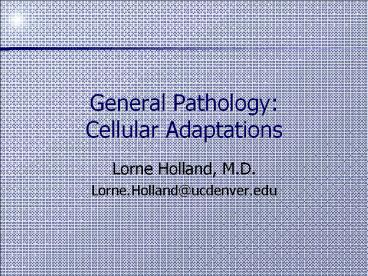General Pathology: Cellular Adaptations - PowerPoint PPT Presentation
1 / 29
Title:
General Pathology: Cellular Adaptations
Description:
General Pathology: Cellular Adaptations Lorne Holland, M.D. Lorne.Holland_at_ucdenver.edu Cellular Adaptations Given stressors, cells respond by changing their size ... – PowerPoint PPT presentation
Number of Views:482
Avg rating:3.0/5.0
Title: General Pathology: Cellular Adaptations
1
General PathologyCellular Adaptations
- Lorne Holland, M.D.
- Lorne.Holland_at_ucdenver.edu
2
Cellular Adaptations
- Given stressors, cells respond by changing their
size, function or composition - Some of these changes may be, at least initially,
beneficial (hypertrophy, hyperplasia, metaplasia) - Some of these changes are maladaptive (atrophy,
hypoplasia) - Left unchecked, some changes can ultimately lead
to cancer (dysplasia)
3
Hypertrophy- too much nourishment
- Increase in cell size without an increase in the
number of cells - Response to increased demand on a cell to do
whatever it does - Classic example- muscle cells in response to
exercise - Other examples- thyroid in response to hormonal
stimulation during puberty - Pathologic example- myocardial cells in response
to chronic, systemic hypertension
4
(No Transcript)
5
Hyperplasia- too much growth
- Increase in the number of cells without an
increase in the size of cells - Response to increased demand on a cell to do
whatever it does - Classic example- regenerating liver after
damage/resection - Other examples- glandular tissue in breast in
response to puberty and pregnancy - Pathologic example- endometrial tissue due to
abnormal/irregular hormonal cycles
6
(No Transcript)
7
(No Transcript)
8
(No Transcript)
9
Hypertrophy and Hyperplasia
- These processes do not have to occur separately
- Usually, both occur though one is by far more
predominant - Classic example- uterine smooth muscle during
pregnancy
10
(No Transcript)
11
Atrophy- no nourishment
- Decrease in organ size due to decreased cell size
and/or decreased number of cells - Physiologic- thymus in adulthood, uterus and
testes in old age - Pathologic- disuse, ischemia, starvation
12
(No Transcript)
13
Hypoplasia- little growth
- Could be visually indistinguishable from atrophy
- Once normal or supernormal tissue which regresses
is atrophic - Tissue which never develops to normal size is
hypoplastic - Similar causes of hypoplasia as atrophy
- In the extreme, aplasia no growth usually due
embryologic failure
14
(No Transcript)
15
Metaplasia- changed growth
- Transformation of one normal cell type into
another normal cells type - Transition of ciliated glandular epithelium to
squamous epithelium in respiratory tissue of
smokers - Transition of squamous epithelium to glandular
epithelium in esophageal reflux - Often, though not always a precursor to dysplasia
16
(No Transcript)
17
Dysplasia- bad growth
- Characterized by one or more
- Hyperplasia especially with increased mitotic
figures - Decreased differentiation
18
Dysplasia- bad growth
- Characterized by one or more (cont.)
- Atypia (not typical appearance)
- Pleomorphism (more forms)
- Variable cell size/shape
- Variable nucleus size/shape
- High nuclear to cytoplasm ratio
- Hyperchromasia (too much color) of nucleus
19
(No Transcript)
20
Neoplasia- new growth
- Unregulated growth of abnormal tissue
- Commonly called a tumor (swelling)
- May or may not be cancer, depending on clinical
behavior (malignant vs. benign)
21
(No Transcript)
22
Calcification
- Abnormal precipitation of calcium in tissue
- Dystrophic due to wear and tear with normal
blood calcium concentrations - Atheromatous plaques
- Heart valves
- Fat necrosis
- Metastatic due to calcium in normal tissue with
elevated blood calcium concentration - Much less frequent but seen in hyperthyroidism,
hypercalcemia of malignancy
23
(No Transcript)
24
Amyloid
- Proteins which layer as B pleated sheets to form
fibrillar structures - Can be highlighted with special stains (Congo
red) - Small amounts can be seen in tissues of normal
elderly people
25
(No Transcript)
26
(No Transcript)
27
Amyloidosis
- AL amyloid
- Due to precipitation of immunoglobulin light
chains produced by abnormal plasma cells - AA amyloid
- Due to precipitation of serum amyloid protein A
produced by liver during inflammation (acute
phase reaction) - Hereditary amyloidosis
- Due to genetic defects in proteins which favor
precipitation
28
Amyloidosis
- Can effect virtually any organ with clinical
symptoms reflective of organ(s) most affected - Predilection for affecting kidneys (filtering)
- Liver and spleen are also often enlarged
29
Questions?































